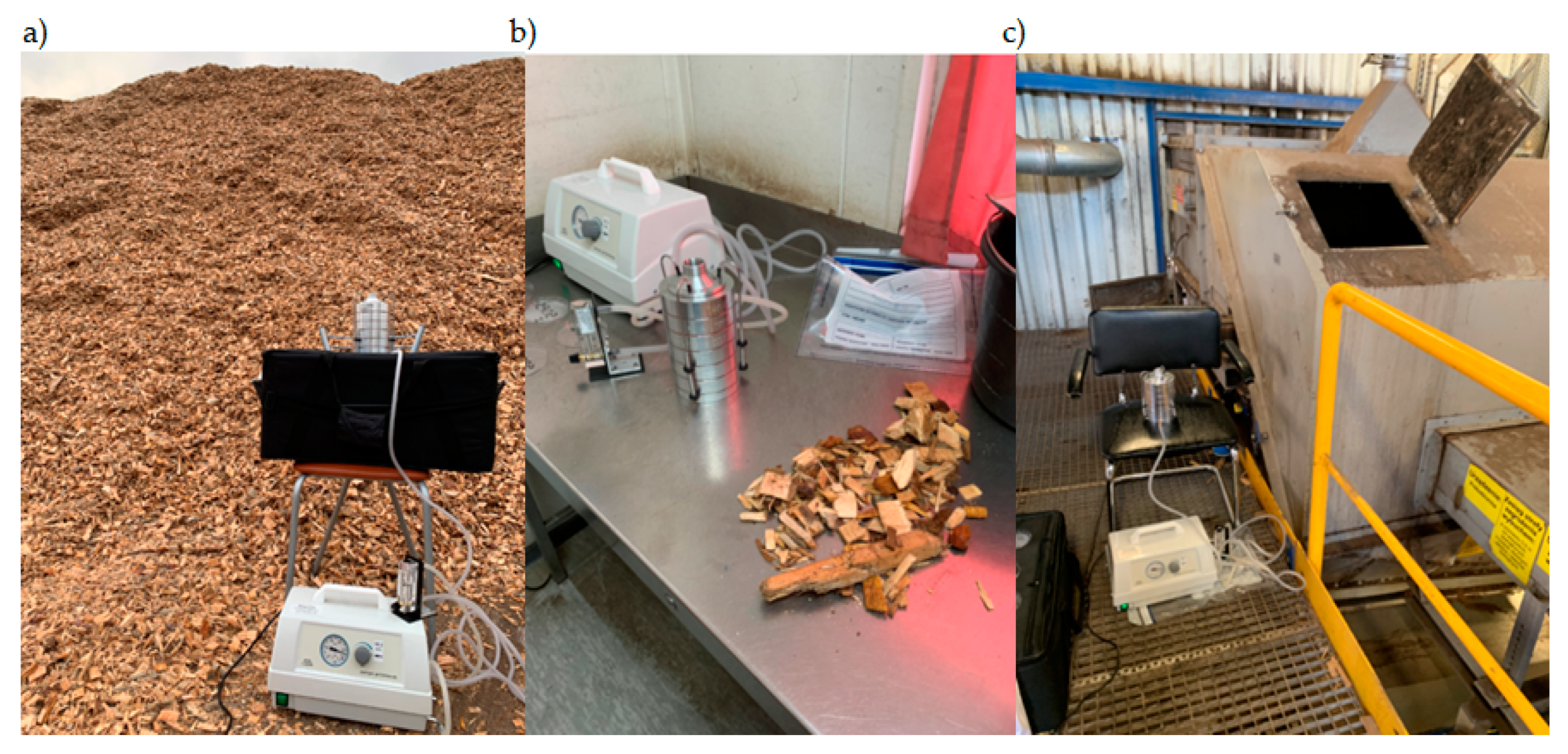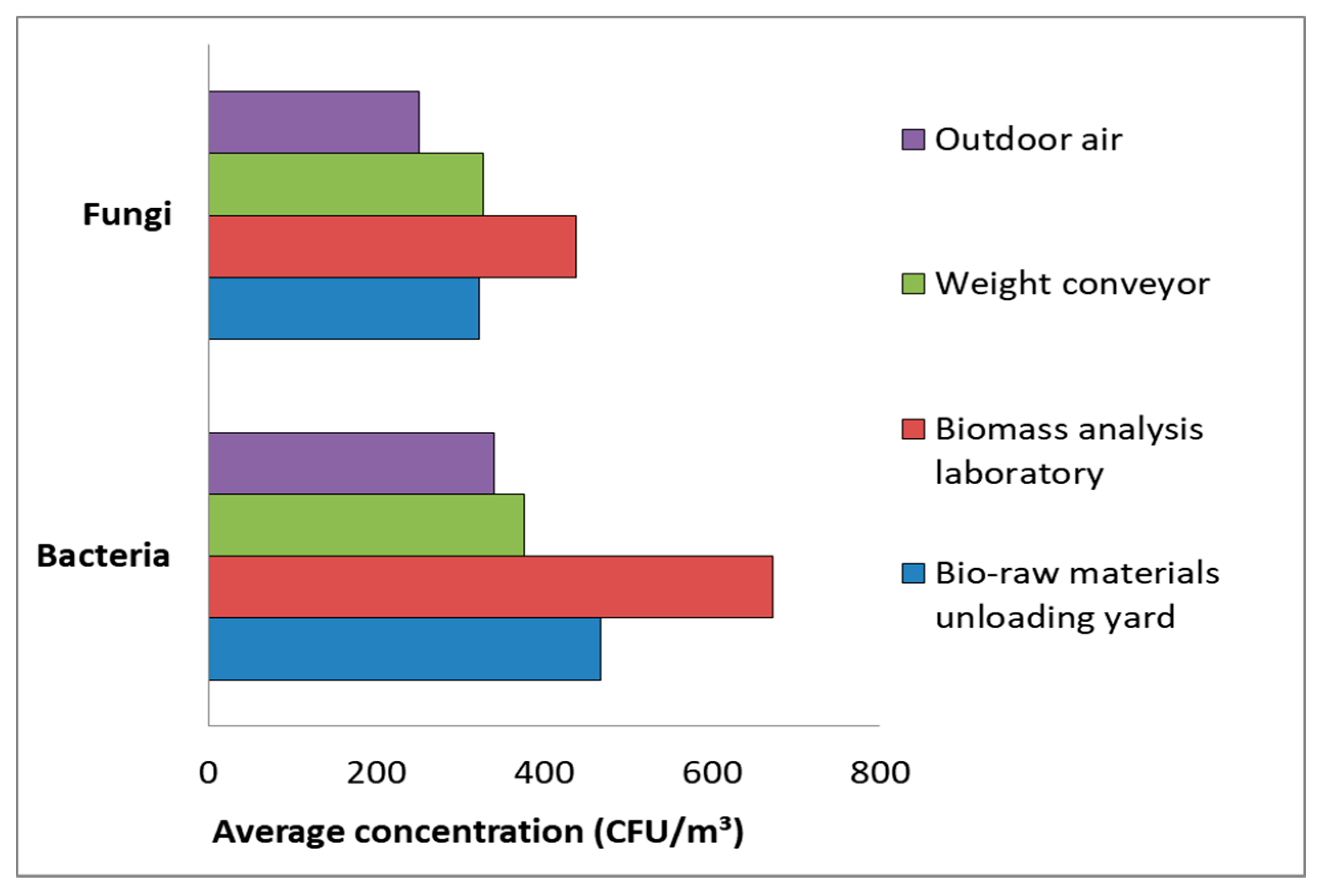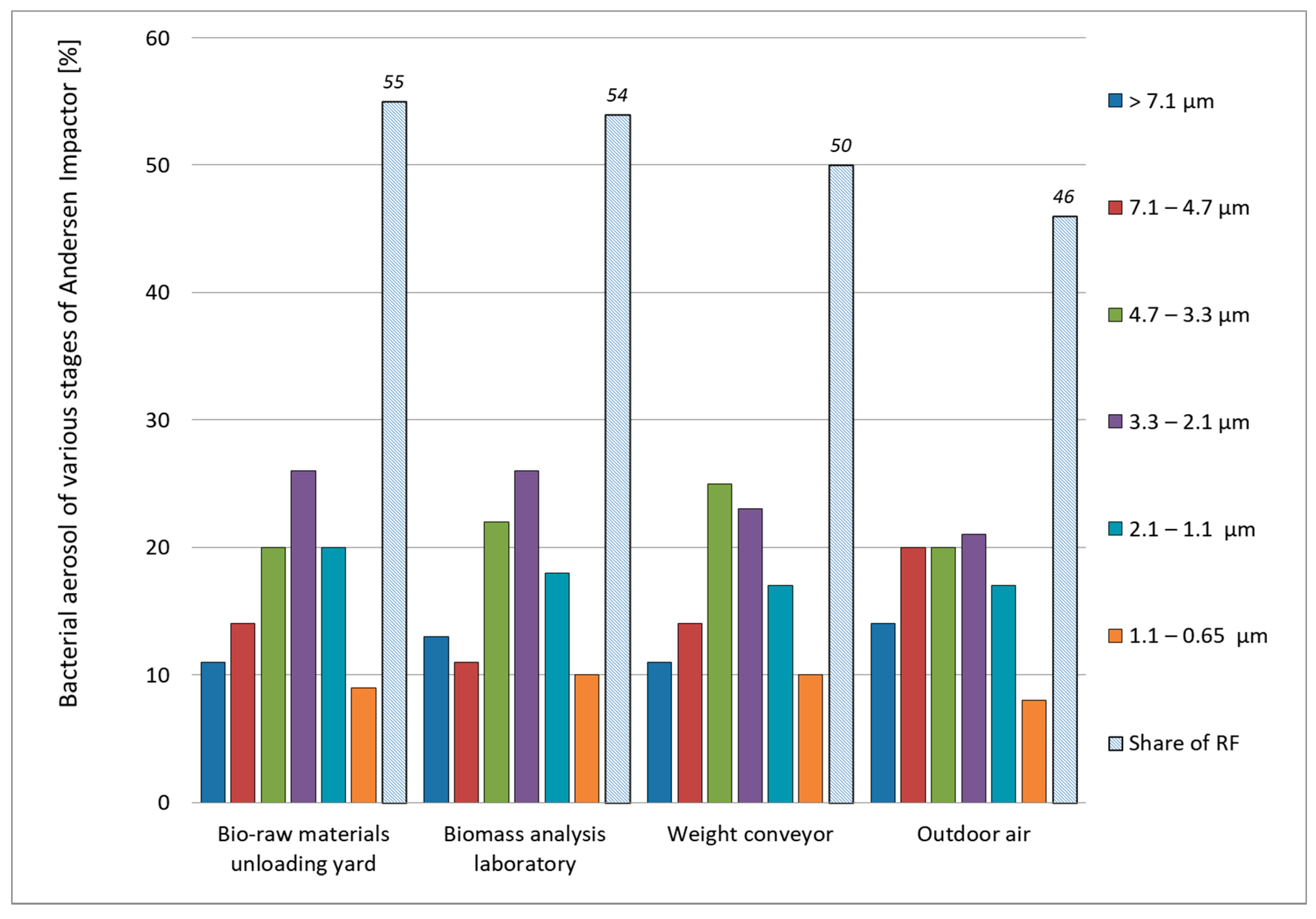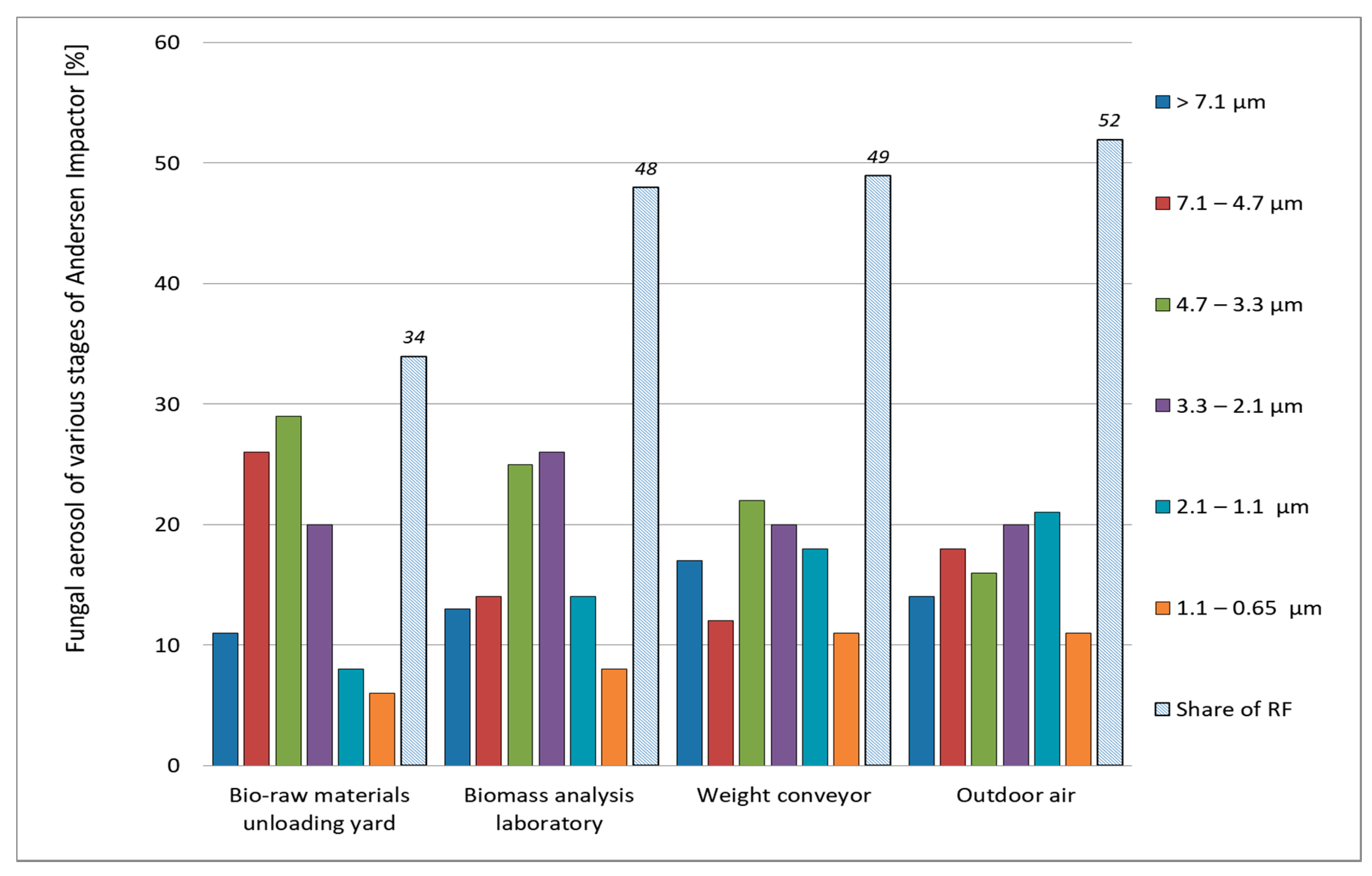Health Risks Associated with Occupational Exposure to Biological Air Pollutants Occurring during the Processing of Biomass for Energy Purposes: A Case Study
Abstract
1. Introduction
2. Materials and Methods
2.1. Sampling Site
2.2. Sampling and Analysis
2.3. Statistical Analyses
3. Results and Discussion
3.1. Total Concentration of Bioaerosol
3.2. Indoor-to-Outdoor-Ratio (I/O)
3.3. Particle Size Distribution (PSD) of Bioaerosols
4. Conclusions
Author Contributions
Funding
Institutional Review Board Statement
Informed Consent Statement
Conflicts of Interest
References
- Drożyner, P.; Rejmer, W.; Starowicz, P.; Klasa, A.; Skibniewska, K. Biomass as a Renewable Source of Energy. Tech. Sci. Univ. Warm. Mazury Olszt. 2013, 16, 211–220. [Google Scholar]
- Janowicz, L. Biomass in Poland. Energy Ecol. 2006, 8, 601–604. (In Polish) [Google Scholar]
- Morimoto, S.; Miyamoto, K. A Current Review of Social Impact Assessment on Sustainable Biomass/Biofuel Development. J. Jpn. Inst. Energy 2009, 88, 133–139. [Google Scholar] [CrossRef][Green Version]
- Paletto, A.; Bernardi, S.; Pieratti, E.; Teston, F.; Romagnoli, M. Assessment of environmental impact of biomass power plants to increase the social acceptance of renewable energy technologies. Heliyon 2019, 5, e02070. [Google Scholar] [CrossRef]
- Rohr, A.C.; Campleman, S.L.; Long, C.M.; Peterson, M.K.; Weatherstone, S.; Quick, W.; Lewis, A. Potential Occupational Exposures and Health Risks Associated with Biomass-Based Power Generation. Int. J. Environ. Res. Public Health 2015, 12, 8542–8605. [Google Scholar] [CrossRef] [PubMed]
- Bruni, E.; Simonetti, G.; Bovone, B.; Casagrande, C.; Castellani, F.; Riccardi, C.; Pomata, D.; Di Filippo, P.; Federici, E.; Buiarelli, F.; et al. Evaluation of Bioaerosol Bacterial Components of a Wastewater Treatment Plant Through an Integrate Approach and In Vivo Assessment. Int. J. Environ. Res. Public Health 2019, 17, 273. [Google Scholar] [CrossRef] [PubMed]
- Freiberg, A.; Scharfe, J.; Murta, V.C.; Seidler, A. The Use of Biomass for Electricity Generation: A Scoping Review of Health Effects on Humans in Residential and Occupational Settings. Int. J. Environ. Res. Public Health 2018, 15, 354. [Google Scholar] [CrossRef]
- Ławniczek-Wałczyk, A.; Gołofit-Szymczak, M.; Cyprowski, M.; Stobnicka, A.; Górny, R.L. Monitoring of bacterial pathogens at workplaces in power plant using biochemical and molecular methods. Int. Arch. Occup. Environ. Health 2017, 90, 285–295. [Google Scholar] [CrossRef] [PubMed]
- A Clean Planet for All. In A European Long-Term Strategic Vision for a Prosperous, Modern, Competitive and Climate Neutral Economy; European Commission: Brussels, Belgium, 2018.
- Koryś, K.A.; Latawiec, A.E.; Grotkiewicz, K.; Kuboń, M. The Review of Biomass Potential for Agricultural Biogas Production in Poland. Sustainability 2019, 11, 6515. [Google Scholar] [CrossRef]
- Baum, R.; Wajszczuk, K.; Pepliński, B.; Wawrzynowicz, J. Potential For Agricultural Biomass Production for Energy Purposes in Poland: A Review. Contemp. Econ. 2013, 7, 63–74. [Google Scholar] [CrossRef]
- Torchio, M.; Lucia, U.; Grisolia, G. Economic and Human Features for Energy and Environmental Indicators: A Tool to Assess Countries’ Progress towards Sustainability. Sustainability 2020, 12, 9716. [Google Scholar] [CrossRef]
- Brodny, J.; Tutak, M.; Saki, S.A. Forecasting the Structure of Energy Production from Renewable Energy Sources and Biofuels in Poland. Energies 2020, 13, 2539. [Google Scholar] [CrossRef]
- Marks-Bielska, R.; Bielski, S.; Pik, K.; Kurowska, K. The Importance of Renewable Energy Sources in Poland’s Energy Mix. Energies 2020, 13, 4624. [Google Scholar] [CrossRef]
- Pronobis, M.; Kalisz, S.; Majcher, J.; Wasylów, J.; Sołtys, J. Possibilities of using biomass in district heating with focus on agricultural biomass as a fuel to replace coal, taking into account economic and technical aspects. Instal 2020, 3, 17–25. (In Polish) [Google Scholar]
- Laitinen, S.; Laitinen, J.; Fagernäs, L.; Korpijärvi, K.; Korpinen, L.; Ojanen, K.; Aatamila, M.; Jumpponen, M.; Koponen, H.; Jokiniemi, J. Exposure to biological and chemical agents at biomass power plants. Biomass Bioenergy 2016, 93, 78–86. [Google Scholar] [CrossRef]
- Dutkiewicz, J. Bacteria and fungi in organic dust as potential health hazard. Ann. Agric. Environ. Med. 1997, 4, 11–16. [Google Scholar]
- Mack, S.M.; Madl, A.K.; Pinkerton, K.E. Respiratory Health Effects of Exposure to Ambient Particulate Matter and Bioaerosols. Compr. Physiol. 2019, 10, 1–20. [Google Scholar]
- Gołofit-Szymczak, M.; Ławniczek-Wałczyk, A. Biomass as a source of biological hazards [Biomasa jako źródło zagrożeń biologicznych]. Bezpieczeństwo Pracy Nauka I Praktyka 2011, 12, 17–19. [Google Scholar]
- Brągoszewska, E. The Dose of Fungal Aerosol Inhaled by Workers in a Waste-Sorting Plant in Poland: A Case Study. Int. J. Environ. Res. Public Health 2019, 17, 177. [Google Scholar] [CrossRef] [PubMed]
- Di Filippo, P.; Pomata, D.; Riccardi, C.; Buiarelli, F.; Perrino, C. Fungal contribution to size-segregated aerosol measured through biomarkers. Atmos. Environ. 2013, 64, 132–140. [Google Scholar] [CrossRef]
- Latif, M.T.; Yong, S.M.; Saad, A.; Mohamad, N.; Baharudin, N.H.; Bin Mokhtar, M.; Tahir, N.M. Composition of heavy metals in indoor dust and their possible exposure: A case study of preschool children in Malaysia. Air Qual. Atmos. Health 2014, 7, 181–193. [Google Scholar] [CrossRef]
- Nasir, Z.A.; Colbeck, I.; Nasar, Z.A. Assessment of Bacterial and Fungal Aerosol in Different Residential Settings. Water Air Soil Pollut. 2010, 211, 367–377. [Google Scholar] [CrossRef]
- Byeon, J.H.; Park, C.W.; Yoon, K.Y.; Park, J.H.; Hwang, J. Size distributions of total airborne particles and bioaerosols in a municipal composting facility. Bioresour. Technol. 2008, 99, 5150–5154. [Google Scholar] [CrossRef] [PubMed]
- Raisi, L.; Aleksandropoulou, V.; Lazaridis, M.; Katsivela, E. Size distribution of viable, cultivable, airborne microbes and their relationship to particulate matter concentrations and meteorological conditions in a Mediterranean site. Aerobiologia 2012, 29, 233–248. [Google Scholar] [CrossRef]
- Li, M.; Qi, J.; Zhang, H.; Huang, S.; Li, L.; Gao, D. Concentration and size distribution of bioaerosols in an outdoor environment in the Qingdao coastal region. Sci. Total Environ. 2011, 409, 3812–3819. [Google Scholar] [CrossRef]
- Ławer, K.M. Skażenie mikrobiologiczne powietrza W miejscowościach atrakcyjnych turystycznie. Kosmos 2019, 68, 429–441. [Google Scholar] [CrossRef]
- Nevalainen, A.; Willeke, K.; Liebhaber, F.; Pastuszka, J.S.; Burge, H.; Henningson, E. Bioaerosol sampling. In Aerosol Measurement: Principles, Techniques and Applications; Willeke, K., Baron, P., Eds.; Van Nostrand Reinhold: New York, NY, USA, 1993; pp. 471–492. [Google Scholar]
- Andersen, A.A. New sampler for the collection, sizing, and enumeration of viable airborne particles. J. Bacteriol. 1958, 76, 471–484. [Google Scholar] [CrossRef]
- PN-EN 12322 In Vitro Diagnostic Medical Devices. Culture Media for Microbiology. Performance Criteria for Culture Media. 2005. Available online: https://ec.europa.eu/growth/single-market/european-standards/harmonised-standards/iv-diagnostic-medical-devices_en (accessed on 20 February 2021).
- ISO 11133 Microbiology of Food, Animal Feed and Water—Preparation, Production, Storage and Performance Testing of Culture Media. 2014. Available online: https://www.iso.org/standard/53610.html (accessed on 20 February 2021).
- Dutkiewicz, J.; Górny, R.L. Biologic factors hazardous to health: Classification and criteria of exposure assessment. Med. Pr. 2002, 53, 29–39. [Google Scholar]
- Mentese, S.; Rad, A.Y.; Arısoy, M.; Gullu, G.H. Seasonal and Spatial Variations of Bioaerosols in Indoor Urban Environments, Ankara, Turkey. Indoor Built Environ. 2011, 21, 797–810. [Google Scholar] [CrossRef]
- Brągoszewska, E. Exposure to Bacterial and Fungal Aerosols: Microorganism Indices in A Waste-Sorting Plant in Poland. Int. J. Environ. Res. Public Health 2019, 16, 3308. [Google Scholar] [CrossRef] [PubMed]
- Lu, R.; Pørneki, A.; Lindgreen, J.; Li, Y.; Madsen, A. Species of Fungi and Pollen in the PM1 and the Inhalable Fraction of Indoor Air in Homes. Atmosphere 2021, 12, 404. [Google Scholar] [CrossRef]
- Owen, M.; Ensor, D.; Sparks, L. Airborne particle sizes and sources found in indoor air. Atmos. Environ. Part A. Gen. Top. 1992, 26, 2149–2162. [Google Scholar] [CrossRef]
- Lacey, J.; Dutkiewicz, J. Bioaerosols and occupational lung disease. J. Aerosol Sci. 1994, 25, 1371–1404. [Google Scholar] [CrossRef]
- Brągoszewska, E.; Pastuszka, J.S. Influence of meteorological factors on the level and characteristics of culturable bacteria in the air in Gliwice, Upper Silesia (Poland). Aerobiologia 2018, 34, 241–255. [Google Scholar] [CrossRef] [PubMed]





| Group | Group I (Wood) | Group II (Agro-Mass) |
|---|---|---|
| Biomass type | Wood chips | Sunflower husk pellets |
| Minimum calorific value [kJ/kg] | 7500 | 16,900 |
| Total moisture value [%] | 51 | 9 |
| Ash value [%] | 5 | 3 |
| Sulphur value [%] | 0.01 | 0.1 |
| Chlorine value [%] | 0.01 | 0.09 |
| Elemental carbon | 23 | 43 |
| No. | Measuring Station |
|---|---|
| 1 | Bio-raw materials unloading yard |
| 2 | Biomass analysis laboratory |
| 3 | Weight conveyor |
| 4 | Outdoor air |
| Average Concentration, CFU/m3 | |||||
|---|---|---|---|---|---|
| Bacteria | Fraction (µm) | Bio-Raw Materials Unloading Yard | Biomass Analysis Laboratory | Weight Conveyor | Outdoor Air |
| >7.1 | 53 | 87 | 42 | 46 | |
| 7.1–4.7 | 67 | 72 | 53 | 68 | |
| 4.7–3.3 | 92 | 147 | 94 | 69 | |
| 3.3–2.1 | 120 | 173 | 87 | 72 | |
| 2.1–1.1 | 92 | 124 | 64 | 57 | |
| 1.1–0.65 | 44 | 71 | 39 | 28 | |
| Total | 468 | 673 | 378 | 341 | |
| RF | 256 | 367 | 190 | 158 | |
| Share (%) of RF | 55 | 54 | 50 | 46 | |
| Fungi | Fraction (µm) | Bio-raw materials unloading yard | Biomass analysis laboratory | Weight conveyor | Outdoor air |
| >7.1 | 35 | 55 | 55 | 35 | |
| 7.1–4.7 | 85 | 60 | 42 | 44 | |
| 4.7–3.3 | 94 | 111 | 71 | 41 | |
| 3.3–2.1 | 65 | 113 | 65 | 51 | |
| 2.1–1.1 | 27 | 62 | 58 | 53 | |
| 1.1–0.65 | 18 | 37 | 35 | 27 | |
| Total | 323 | 438 | 327 | 251 | |
| RF | 110 | 212 | 159 | 131 | |
| Share (%) of RF | 34 | 48 | 49 | 52 | |
Publisher’s Note: MDPI stays neutral with regard to jurisdictional claims in published maps and institutional affiliations. |
© 2021 by the authors. Licensee MDPI, Basel, Switzerland. This article is an open access article distributed under the terms and conditions of the Creative Commons Attribution (CC BY) license (https://creativecommons.org/licenses/by/4.0/).
Share and Cite
Brągoszewska, E.; Pawlak, M. Health Risks Associated with Occupational Exposure to Biological Air Pollutants Occurring during the Processing of Biomass for Energy Purposes: A Case Study. Energies 2021, 14, 2086. https://doi.org/10.3390/en14082086
Brągoszewska E, Pawlak M. Health Risks Associated with Occupational Exposure to Biological Air Pollutants Occurring during the Processing of Biomass for Energy Purposes: A Case Study. Energies. 2021; 14(8):2086. https://doi.org/10.3390/en14082086
Chicago/Turabian StyleBrągoszewska, Ewa, and Maja Pawlak. 2021. "Health Risks Associated with Occupational Exposure to Biological Air Pollutants Occurring during the Processing of Biomass for Energy Purposes: A Case Study" Energies 14, no. 8: 2086. https://doi.org/10.3390/en14082086
APA StyleBrągoszewska, E., & Pawlak, M. (2021). Health Risks Associated with Occupational Exposure to Biological Air Pollutants Occurring during the Processing of Biomass for Energy Purposes: A Case Study. Energies, 14(8), 2086. https://doi.org/10.3390/en14082086







